格莱珉信托简介
外文翻译--格莱珉乡村银行的经济价值
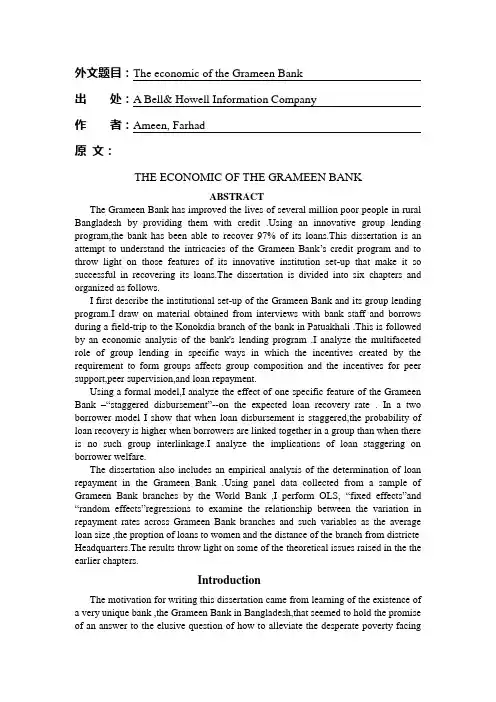
外文题目:The economic of the Grameen Bank出处:A Bell& Howell Information Company作者:Ameen, Farhad原文:THE ECONOMIC OF THE GRAMEEN BANKABSTRACTThe Grameen Bank has improved the lives of several million poor people in rural Bangladesh by providing them with credit .Using an innovative group lending program,the bank has been able to recover 97% of its loans.This dissertation is an attempt to understand the intricacies of the Grameen Bank’s credit program and to throw light on those features of its innovative institution set-up that make it so successful in recovering its loans.The dissertation is divided into six chapters and organized as follows.I first describe the institutional set-up of the Grameen Bank and its group lending program.I draw on material obtained from interviews with bank staff and borrows during a field-trip to the Konokdia branch of the bank in Patuakhali .This is followed by an economic analysis of the bank's lending program .I analyze the multifaceted role of group lending in specific ways in which the incentives created by the requirement to form groups affects group composition and the incentives for peer support,peer supervision,and loan repayment.Using a formal model,I analyze the effect of one specific feature of the Grameen Bank –“staggered disbursement”--on the expected loan recovery rate . In a two borrower model I show that when loan disbursement is staggered,the probability of loan recovery is higher when borrowers are linked together in a group than when there is no such group interlinkage.I analyze the implications of loan staggering on borrower welfare.The dissertation also includes an empirical analysis of the determination of loan repayment in the Grameen Bank .Using panel data collected from a sample of Grameen Bank branches by the World Bank ,I perform OLS, “fixed effects”and “random effects”regressions to examine the relationship between the variation in repayment rates across Grameen Bank branches and such variables as the average loan size ,the proption of loans to women and the distance of the branch from districte Headquarters.The results throw light on some of the theoretical issues raised in the the earlier chapters.IntroductionThe motivation for writing this dissertation came from learning of the existence of a very unique bank ,the Grameen Bank in Bangladesh,that seemed to hold the promise of an answer to the elusive question of how to alleviate the desperate poverty facingmillions in the developing world .The answer appeared to lie in the bank’s use of an innovative group lending program that embodies many ideas found in the theories of games,incentives and information.The application of principles of economic theory to an urgent policy question proved irresistible as a choice for a dissertation.thereupon I set to understand the intricacies of the Grameen Bank’s credit program and to throw light on those features of its innovative institutional set-up that make it so successful.Today, the Grameen Bank has over two million borrowers,who are among the poorest people in Bangladesh,and 94% of whom are women.With more than a thousand branches,the bank serves borrowers in over half of Bangladesh’s 68,000 villages .As a testimonial to its success,scores of banks and credit programs around the world have been patterned after the Grameen Bank’s institutional set-up.These are to be found in countries at very different stages of economic development,from Tanzania to the United States.From its inception as an experimental project in the late 70s,the focus of the bank has been to provide credit to the poor and landless in Bangladesh ,who were not considered creditworthy by the commercial banks. Acoording to the bank’s visionary founder,Dr.Muhammad Yunus,the poor have many income-generating skills which they cannot successful utilize for lack of employment opportunities and of seed captial for self-employment.Providing them with credit to help them start their own income-earning projects is the most promising way to enable them to emerge from the grips of poverty. At the same time ,he wanted to ensure that these loans did not become “grants”as had been the case with many previous subsidized credit programs.Grameen Bank : The Institutional set-up1.The Grameen Bank’s Organization and performanceSince the early 1980’s,the Grameen Bank has been operating as a full-fledged bank. As of January 1996 the bank had 1,055 branches with 2,063,640 borrowers. Women comprised 94% of the borrowers.The cumulative amount of loans disbursed as of January 1996 was US $1,662.70 million.The bank had operations in 35,569 of Bangladesh’s 68,000 villages,employing 10,861 persons.The bulk of these e mployees worked in regional branches and only 4% were emplyed in the bank’s head office in Dhaka.The Grameen Bank is an independent bank with 75% of its shares held by borrowers and the remaining 25% held by the government.More than 97% of all loans made by the bank are repaid on time.In contrast,the government agricultural bank in Bangladesh recovers only 50% of its loans.The bank obtains most of its funds at concessionary rates from the Bangladesh Bank (the central bank of Bangladesh)and several donor agencies including the Internationl Fund for Agricultural Development (IFAD),the international development agencies of Norway,Netherlands and Sweden,as well as the Ford Foundation.One of the bank’s long-term goals is financial self-sufficiency.To this end,it has mobilized borrower deposits in savings accounts.As of January 1996,the cumulative amount of savings was over US $128million.The Grameen Bank’s loans to borrowers are currency made at a nominal interest rate of 20%.2.The Grameen Bank Today: New ActivitiesOver time,the Grameen Bank has branched out into newer activities.When the bank first started,it concerned on disturbing general loans to individual borrowers.It then started giving collective loans to groups of borrowers,sometimes to a whole center jiontly.House-building loans were introduced in 1984.These loans are given only to borrowers who have demonstrated good repayment performance.Loans are much larger than general loans(about TK.15,000).They are repayable over 10 years and carry an interest rate of 8%,in contrast to the 20% rate on other loans.The borrower is required to hold title to the land on which the house is built.Borrowers with house-building loans usually also have a general loan.They are thus able to use part of the proceeds from the use of the general loans to help repay their housing loans.About 10% of the total loan disbursement currently gose toward housing loans.More recently,the Grameen Bank has started offering “technology”loans.These loans are ofen used collectively for larger and more technology-intensive,and therefore more expensive,projects.These loans constitutes a little more than 3% of the total amount of loans disbursed.In addition to its loan programs,the Grameen Bank has several independent affiliated organizations.These include the Grameen Trust and the Grameen Uddog.The Grameen Trust is a non-profit organization that has several programs aimed at disseminating information about the Grameen Bank’s operation in order to help replication efforts of Grameen-type credit programs around the world. The Grameen Trust,in conjunction with the Grameen Bank,organizes and conducts the annual Grameen Internationl Dialogue Programmes.These programs are a series of seminars and workshops held in Dhaka,to provide an “op portunity for participants to gain first hand exposure to the philosophy and operational procedures of Grameen Bank.The trust also has a research program called the Programme for Research on Poverty Alleviation.This programs sponsors,publicizes,and partially funds local costs of reserch related to poverty alleviation.The Grameen Uddog helps thousands of poor handloom weavers spread throughout Bangladesh.Many of these weavers had handloom machines and skills to make a very inexpensive cotton fabric.Yet ,many of these looms remained unutilized because most of the weavers had little seed money or access to loans to enable them to buy the thread and other materials required to make the fabrics.They also lacked the resources necessary to market the product.The Grameen Bank has also expanded in other sectors with the aim of increasing commercial agricultural production and income,while enhancing soil capacity and other social goals. The Bank is also increasingly involved in replication efforts throughout the world.As testimony to the success of its efforts,there are now scores of successful Grameen-type credit programs throughout the world.Economic and the Grameen Bank1.loan contracts:problems to overcomeEvery loan contract involves the giving up of a sum of money by a lender in oneperiod in exchange for a promise by the borrower to repay the money plus an interest amount in a future period.Because the exchange takes place over time,the lender must decide whether to make a loan to a certain borrower and then,if the loan is made,he must find ways to ensure that the borrower in fact repays the money.2.The Grameen Bank and EconomicsThe Grameen Bank was created to serve a particular clientele,or target group.They were the landless or near-landless in the rural areas of Bangladesh.They were among the poorest people in Bangladesh with little income earning resources other than their labor.The founder of the Grameen Bank believed that access to credit was instrumental in enabling this group to acquire productive resources which they could use to set up income generating projects of their own .The Grameen Bank,therefore,had to design a credit delivery and recovery scheme for this particular group of potential borrowers who were effectively shut out of the formal credit market,and could not profitably use the high interest loans in the informal credit market.What they need was access to loans at the rates charged by the commercial banks but without having to put up material collateral. The Grameen Bank’s innovative institutional features were designed to specifically address the requirements of this group of borrowers.The bank had to ensure that only borrowers who fit the target group characteristics would get loans,and that others would be screened out .And that once they received the loans,they would take those actions that would increase the probability of success of their projects,and finally that they would be compelled to repay their loans.The Grameen Bank’s “sixteen decisions”Millions of poor people in the developing world suffer from extreme levels of poverty.Decades of poverty-reduction efforts by governments have been only marginally successful.In the midst of this sobering picture,the success of the Grameen Bank in improving the lives of several millions of the poorest in Bangladesh stands out as a bright ray of hope.Recognizing credits as the key ingredient in development, the bank has devised an ingenuous loan program for the landless in rural Bangladesh who are severely constrained in their access to ing its innovative group lending scheme,the has not only provided credit but has achieved an enviable loan recovery performance.Encouraged by its success,scores of Grameen Bank replications have spurng up around the world,from Africa to Arkansas.Although replication efforts continue,we still do not understand which,if any,of the bank’s institutional features are critical to its success. For successful implementation of similar programs in other countries and environments,it is imperative that we understand the role of each of the bank’s institutional features.This dissertation has been an attempt to throw light on the reasons behind the bank’s excellent loan recovery performce.Drawing on the analytical literature in economics,I have tried to illustrate the ways in which the different features of the bank’s group lending program help to enhance loan repayment.The group formation process performs important screening functions.Group liability helps to provide multual insurance as well as incentives forpeer supervision.Staggered disbursement of loans enhance peer support,and therefore,loan repayment.Repeat loans and the harness of social collateral prevent willful default.Sixteen decisions1. the four principle of Grameen Bank-discipline,unity,courage,and hard work-weshall follow and advance in all walks of our lives.2. we shall bring prosperity to our families.3.we shall not live in dilapidated houses.we shall eat plenty of them and sell thesurplus.4.we shall grow vegetables all the year roud. We shall plants as many seedings aspossible .5.during the planting seasons,we shall plants as many seedings as possible.6.we shall plan to keep our families small .we shall minimize our expenditures.weshall look after our health.7.we shall educate our children and ensure that they can earn enough to pay for theeducation.8.we shall always keep our children and the environment clean.9.we shall build and use pit laterines.10.we shall drink tubewell water.If it is not available,we shall boil water or use alum.11.we shall not take any dowry in our son’s weddings,neither shall we give anydowry in our daughters’ weddings.We shall keep the center free from the curse of dowry.We shall not practice child marriage.12.We shall not inflict any injustice on anyone,neither shall we allow anyone to doso.13.for higher income we shall collectively undertake bigger investments.14.we shall always be ready to help each other.If anyone is in difficultly,we shall allhelp.15.if we come to know of any breach of discipline in any center,we shall all go thereand help restore discipline.16.we shall introduce physical exercise in all our centers.We shall take part in allsocial activities collectively.外文题目:The economic of the Grameen Bank出处:A Bell& Howell Information Company作者:Ameen, Farhad译文:格莱珉乡村银行的经济价值摘要格莱珉银行在孟加拉国乡下通过提供信用贷款计划,提高了数百万穷人的生活。
格莱珉模式与中国村镇银行的运营策略和风险控制研究的开题报告
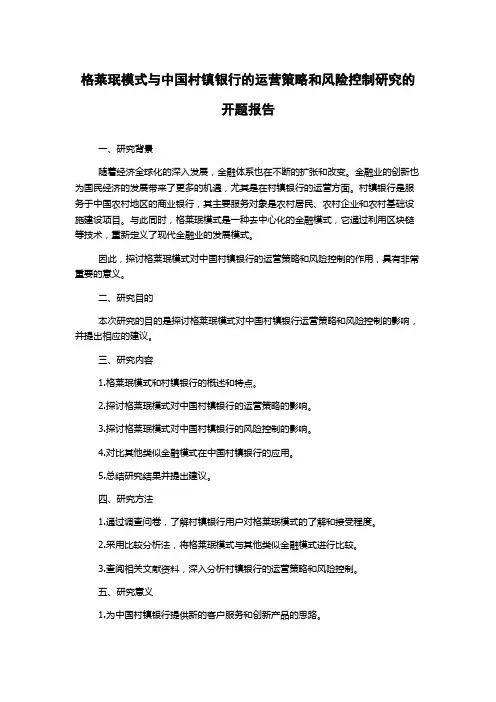
格莱珉模式与中国村镇银行的运营策略和风险控制研究的
开题报告
一、研究背景
随着经济全球化的深入发展,金融体系也在不断的扩张和改变。
金融业的创新也为国民经济的发展带来了更多的机遇,尤其是在村镇银行的运营方面。
村镇银行是服务于中国农村地区的商业银行,其主要服务对象是农村居民、农村企业和农村基础设施建设项目。
与此同时,格莱珉模式是一种去中心化的金融模式,它通过利用区块链等技术,重新定义了现代金融业的发展模式。
因此,探讨格莱珉模式对中国村镇银行的运营策略和风险控制的作用,具有非常重要的意义。
二、研究目的
本次研究的目的是探讨格莱珉模式对中国村镇银行运营策略和风险控制的影响,并提出相应的建议。
三、研究内容
1.格莱珉模式和村镇银行的概述和特点。
2.探讨格莱珉模式对中国村镇银行的运营策略的影响。
3.探讨格莱珉模式对中国村镇银行的风险控制的影响。
4.对比其他类似金融模式在中国村镇银行的应用。
5.总结研究结果并提出建议。
四、研究方法
1.通过调查问卷,了解村镇银行用户对格莱珉模式的了解和接受程度。
2.采用比较分析法,将格莱珉模式与其他类似金融模式进行比较。
3.查阅相关文献资料,深入分析村镇银行的运营策略和风险控制。
五、研究意义
1.为中国村镇银行提供新的客户服务和创新产品的思路。
2.提高村镇银行的竞争力和风险防范能力,促进中国金融行业的创新和发展。
3.为其他类似机构提供参考和借鉴。
格莱珉中国
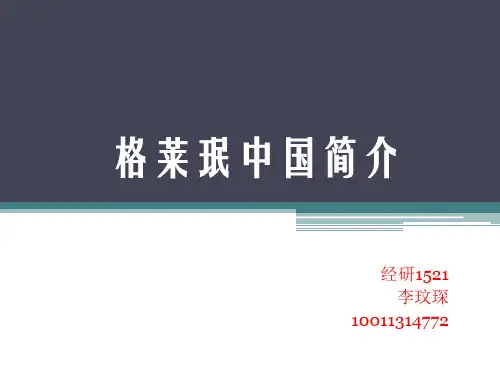
• 4,双方还将共同合作拓展农村领域的消费和创业贷款。
与京东合作
• 2014年底,京东集团与格莱珉中国达成战略合作 意向,借助京东渠道和供应链资源,格莱珉在农 村微金融服务领域经验,开拓中国农村金融市场 。 • 尤努斯教授邀请刘强东加入格莱珉中国董事会, 成第一名企业董事成员。
• 1,京东集团将与格莱珉中国共同探讨创造一个中国互 联网金融样本——京东格莱珉金融模式,研究探索银行 金融服务、供应链金融、众筹、大数据风控等方面与线 下格莱珉微金融模式形成互补结合,最终让京东渠道下 沉战略和和格莱珉小微金融模式遍布到中国村镇市场。 • 2,京东金融旗下的众筹事业部将与格莱珉中国合作, 运用众筹平台为格莱珉中国业务开展进行筹款。 • 3,京东集团将与格莱珉中国在农村小额贷款业务领域 展开合作,从京东自建的配送网络入手,由京东金融小 贷部门、配送部门和格莱珉共同为农民提供金融合作解 决方案。
运营方式
• 1.无法获得主流金融服务的妇女寻找其他四名与 她一样有贷款需求的人组成小组; • 2.五人小组参加为期五天的培训,提高财务管理 能力,培训结束后,每位成员将获得首批贷款, 扩大其经营活动; • 3.每周举行还款会议,借款和利息以周为单位归 还,创造扩大妇女社会支持网络的机会,互相吉 利创业; • 4.帮助妇女成为成功的创业者。
格莱珉中国简介
经研1521 李玟琛 10011314772
格莱珉银行产生背景
• 是孟加拉乡村银行一个发行微型贷款的机构。创 建于 1983 年,是由尤努斯教授在乔不拉村的一 个实验项目发展而来。 • 孟加拉国经济基础薄弱,农民生活水平极其低下, 主要以农业为主。根据世界银行统计,孟加拉国 贫困人口比例为48.9%(2000)、40%(2005)、 31.5%(2010)。
格莱珉模式与中国村镇银行的发展之路
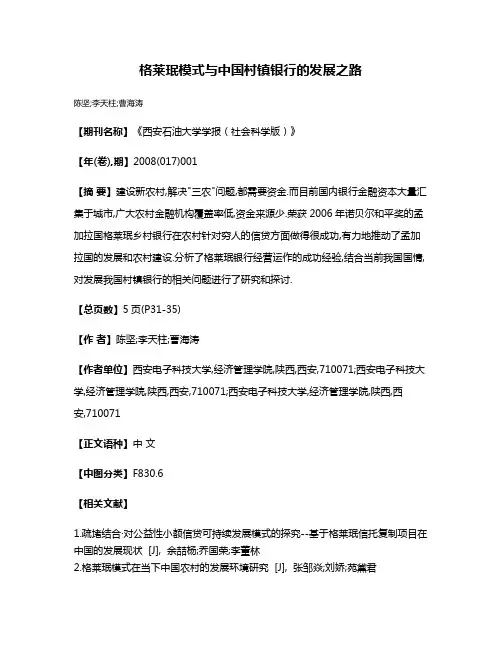
格莱珉模式与中国村镇银行的发展之路
陈坚;李天柱;曹海涛
【期刊名称】《西安石油大学学报(社会科学版)》
【年(卷),期】2008(017)001
【摘要】建设新农村,解决"三农"问题,都需要资金.而目前国内银行金融资本大量汇集于城市,广大农村金融机构覆盖率低,资金来源少.荣获2006年诺贝尔和平奖的孟加拉国格莱珉乡村银行在农村针对穷人的信贷方面做得很成功,有力地推动了孟加拉国的发展和农村建设.分析了格莱珉银行经营运作的成功经验,结合当前我国国情,对发展我国村镇银行的相关问题进行了研究和探讨.
【总页数】5页(P31-35)
【作者】陈坚;李天柱;曹海涛
【作者单位】西安电子科技大学,经济管理学院,陕西,西安,710071;西安电子科技大学,经济管理学院,陕西,西安,710071;西安电子科技大学,经济管理学院,陕西,西安,710071
【正文语种】中文
【中图分类】F830.6
【相关文献】
1.疏堵结合·对公益性小额信贷可持续发展模式的探究--基于格莱珉信托复制项目在中国的发展现状 [J], 余喆杨;乔国荣;李董林
2.格莱珉模式在当下中国农村的发展环境研究 [J], 张邹焱;刘娇;苑黛君
3.格莱珉模式小额信贷在中国发展现状——以内蒙古格莱珉商都小额货款有限责任公司为例 [J], 余友昌;曹静;王艳
4.格莱珉银行模式对中国村镇银行发展的启示 [J], 丁桂萍
5.格莱珉中国发展模式对我国普惠金融的启示研究
——基于格莱珉中国项目点的实地调研 [J], 孔令佳;张婷玉
因版权原因,仅展示原文概要,查看原文内容请购买。
格莱珉银行运作模式解析
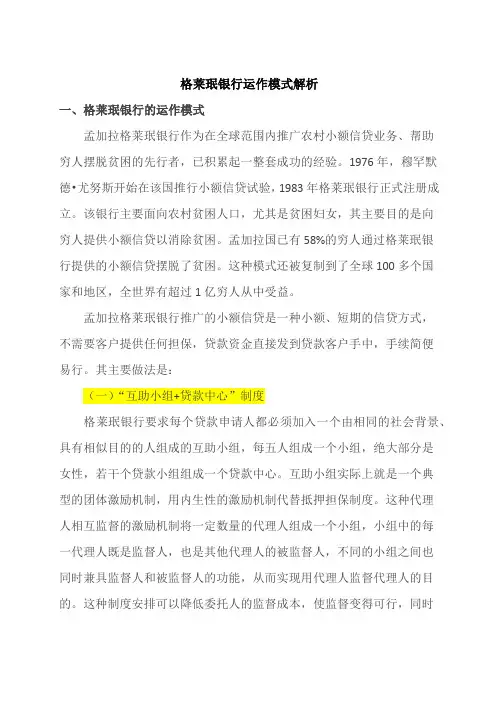
格莱珉银行运作模式解析一、格莱珉银行的运作模式孟加拉格莱珉银行作为在全球范围内推广农村小额信贷业务、帮助穷人摆脱贫困的先行者,已积累起一整套成功的经验。
1976年,穆罕默德•尤努斯开始在该国推行小额信贷试验,1983年格莱珉银行正式注册成立。
该银行主要面向农村贫困人口,尤其是贫困妇女,其主要目的是向穷人提供小额信贷以消除贫困。
孟加拉国已有58%的穷人通过格莱珉银行提供的小额信贷摆脱了贫困。
这种模式还被复制到了全球100多个国家和地区,全世界有超过1亿穷人从中受益。
孟加拉格莱珉银行推广的小额信贷是一种小额、短期的信贷方式,不需要客户提供任何担保,贷款资金直接发到贷款客户手中,手续简便易行。
其主要做法是:(一)“互助小组+贷款中心”制度格莱珉银行要求每个贷款申请人都必须加入一个由相同的社会背景、具有相似目的的人组成的互助小组,每五人组成一个小组,绝大部分是女性,若干个贷款小组组成一个贷款中心。
互助小组实际上就是一个典型的团体激励机制,用内生性的激励机制代替抵押担保制度。
这种代理人相互监督的激励机制将一定数量的代理人组成一个小组,小组中的每一代理人既是监督人,也是其他代理人的被监督人,不同的小组之间也同时兼具监督人和被监督人的功能,从而实现用代理人监督代理人的目的。
这种制度安排可以降低委托人的监督成本,使监督变得可行,同时也更有效。
它有效地降低了银行的监管成本,将银行的外部的监督转化为成员自身的内部监督;同时,小组内部还能激发起更大的竞争意识和更强烈的相互支撑意识。
严密的组织和制度保障,使各贷款成员之间形成相互支持、相互监督的氛围,保证了较高的还款率。
(二)“顺序放贷+分期还款”制度。
格莱珉银行在小组内采用2-2-1顺序放贷,即最初只有2名成员可以申请贷款。
根据他们的偿还情况,另2名成员再申请贷款,小组组长最后得到贷款,并监督还款情况。
通过顺序放贷这一机制,轻而易举将小组长变成免费的“风险控制官”。
小额贷款期限一般为一年,采用每周偿还的方式,一年内还清贷款。
专访格莱珉信托执行主席拉蒂菲教授:“小额信贷是战胜贫困的工具”
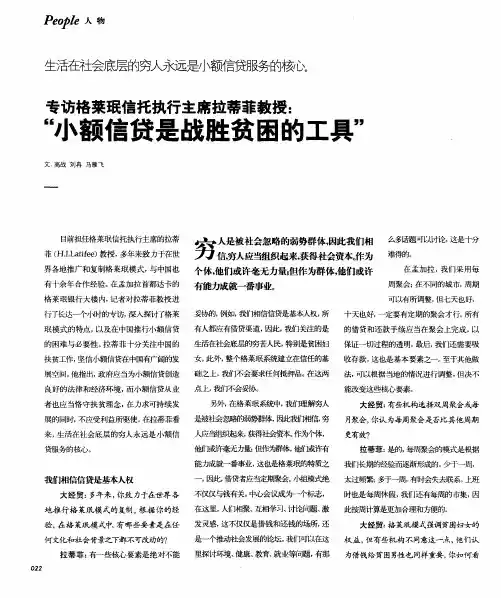
何 文化和社会 背景之下都 不可改动的?
拉 蒂菲 : 有一些核心要素是绝对不能
02 2
是一个推动社会发展的论坛。 我们可以在这 权 益 , 但有些机 构不 同意这 _ 占, 、他们认 里探讨环境、 健康、 教育、 就业等问题, 有那 为借 钱给 贫困男性也 同样重要, 你如 何看
后, 她更 的往往不是自 而是孩 这 己, 就是我们所考虑的重点。 我们相信, 将重点
放在妇女身上,
ห้องสมุดไป่ตู้的效果。
令项 目 进展缓慢。 但是我们相信, 只要有贫 能的 。 立法或修法的过程是非常复杂的, 中 穷存在 , 就有小额信 贷发展 的空间。 因此
我们会十分耐 。
。
国有杜晓 山 先生等 人致力于推动相关法规,
何克服由此带来的挑 ? 戈
拉 蒂菲 : 首先你得有一些种子基金, 可
人都很支持我们, 所有 人 都饱含热 情, 但他
们帮不上忙 , 因为有各种规 矩 。 我们 必须 能 通过贷款或资助得来 。 如果不能吸收存
经过层层 申 , 请 这些手 续非常浪费时 间,
款, 你发展的速度会十分缓慢, 但仍旧是可
收存款, 这也是基本要素之・。 至于其t  ̄ - ' Ni
法, 可以根据 当地的情况进行调 整, 但决不
展空 间。 他指出, 政府应当为小额信贷创造 础之上 , 我们不会要求任何抵押品。 在这两 良好 的法律和经济环境 , 而小额信 贷从业
者也应 当恪 守扶贫理念 , 力求可持续发 在 点上, 我们不会妥协。 另外, 在格莱珉系统 中, 我们理解穷人 因此我f 信, 『 目 穷 , 彳 教- 与 资本。 作 体 ,
J 信' 穷人应当组织起来, 获得社会资本。 作为
格莱珉银行的关系融资模式
格莱珉银行的关系融资模式【摘要】格莱珉银行的关系融资模式是一种基于建立有效关系网络来获取资金支持的金融模式。
本文主要从关系融资模式的特点、优势、应用案例、发展趋势以及影响力等方面进行了探讨。
格莱珉银行关系融资模式的特点包括建立长期关系、信任度高、灵活性强等。
优势在于降低融资成本、提高融资效率、推动企业发展等方面。
通过分析实际案例,可以看到该模式在不同行业和实践中的应用情况。
未来,格莱珉银行的关系融资模式将继续受到关注,发展趋势可能体现在技术创新、金融产品创新等方面,且在金融领域中的影响力也将进一步增强。
格莱珉银行关系融资模式具有广阔的未来展望,有望在金融领域中发挥更大作用。
【关键词】格莱珉银行、关系融资模式、特点、优势、应用案例、发展趋势、影响力、未来展望1. 引言1.1 格莱珉银行的关系融资模式概述格莱珉银行的关系融资模式具有以下特点:注重建立长期稳定的合作关系。
通过与客户建立紧密的合作关系,银行能够深入了解客户的需求和情况,为其量身定制最适合的融资方案。
强调专业化服务。
银行拥有一支经验丰富、专业素质过硬的团队,能够为客户提供专业的融资咨询和服务。
注重风险管控。
银行通过严格的风险管控体系,确保资金安全和项目稳健发展。
格莱珉银行的关系融资模式以客户为中心,注重建立互信互利的合作关系,为客户提供定制化、专业化的金融服务。
随着市场竞争日趋激烈,格莱珉银行将不断创新和完善其关系融资模式,以更好地满足客户需求,实现共赢共享的目标。
2. 正文2.1 格莱珉银行关系融资模式的特点格莱珉银行关系融资模式的特点主要包括以下几个方面:该模式注重建立长期稳定的合作关系,不仅限于一次性的交易,而是通过持续的合作,共同成长。
格莱珉银行关系融资模式强调风险共担和共享,银行不仅提供融资支持,还会与企业分享风险,共同应对市场波动。
该模式注重个性化服务,银行会根据客户的实际需求和情况,量身定制相应的融资方案,提供更加贴近客户需求的服务。
格莱珉银行对中国银行业的启示
格莱珉银行对中国银行业的启示【摘要】格莱珉银行作为国际知名的银行,其成功经验为中国银行业提供了宝贵的启示。
中国银行业在现有状况下存在一些不足之处,如管理机制不够灵活、科技创新落后等。
格莱珉银行的管理模式给中国银行业指明了发展方向,强调灵活性和创新。
科技创新对银行业的意义也被凸显出来,提升服务效率和客户体验。
合作与竞争共存的重要性也在格莱珉银行的成功经验中得到体现。
格莱珉银行为中国银行业带来了启示,中国银行业可以借鉴其成功经验,加强科技创新,合理运用合作与竞争的理念,展望未来发展方向,实现更好的发展。
【关键词】格莱珉银行、中国银行业、成功经验、管理模式、科技创新、合作、竞争、启示、发展方向、未来1. 引言1.1 格莱珉银行简介格莱珉银行以其丰富的经验和优秀的业绩在国际金融市场上占据着重要地位,为其它银行树立了榜样。
1.2 中国银行业现状中国银行业作为我国金融体系的重要组成部分,扮演着至关重要的角色。
目前,中国银行业整体发展较为稳健,资产规模不断扩大,金融服务水平逐步提升。
中国银行业也存在一些问题和挑战。
传统银行业务模式仍然占主导地位,互联网金融等新兴业态发展尚未完全成熟,银行业面临着转型升级压力。
风险控制能力有待提升,金融市场波动性增加,市场化风险较为突出。
金融科技发展日新月异,传统银行面临着数字化转型的紧迫需求,需要加大对科技创新的投入和研发。
银行间的竞争也越发激烈,需要不断加强服务水平和产品创新能力,提升自身核心竞争力。
中国银行业在面临机遇和挑战的也需要不断调整和改进自身发展模式,提升服务水平,保持稳健发展的动力。
2. 正文2.1 格莱珉银行的成功经验格莱珉银行在客户服务上非常注重个性化和定制化。
他们通过深入了解客户需求,为客户提供个性化的金融产品和服务,提升了客户满意度和忠诚度。
格莱珉银行在风险管理上做得非常出色。
他们建立了严格的风险管理体系,通过科学的风险评估和控制,有效降低了不良资产比例,保障了银行的稳健经营。
【历届诺贝尔奖得主(十一)】2006年和平奖3
格拉明乡村银行的成功模式激励了其他发展中国家,甚至是已发展国家,如美国,进而发展出类似的成功经验.这种微型贷款模式目前已经在23个国家中进行.其中,有许多微型贷款计划特别偏重于贷款给女性,超过96%的格拉明贷款都是借给女性的,他们不均衡地遭受贫穷之苦,但同时也比男人奉献更多的收入以供家庭所需与世界贫困现象的战争尤努斯独特的实用主义哲学,虽然可能让他难以获得诺贝尔经济学奖——一般都是颁给那些理论性的成果。
但是尤努斯并不在意,他关注的是消灭这个世界的贫穷现象。
他也很清楚,对抗贫穷的这场战争还远没有到可以庆祝胜利的时刻。
格莱珉银行仅仅覆盖了孟家拉75%的穷人,在其他国家地区还只有10%。
因此在1989年,尤努斯创建了格莱珉信托基金,募集资金为亚、非、欧、拉丁美洲等30多个国家100多个组织在复制格莱珉银行时提供支援,目前已提供了1,600多万美元的援助资金。
1998年,一场世纪洪水肆虐孟加拉长达2个多月,造成大量穷人家庭资产损毁,尤努斯也在此时对格莱珉银行20多年的运作进行了反思,最后作出了大胆的改革,推出了全新体系的“第二代格莱珉银行”,取消了原有的一些贷款种类、借款约束以及“团结组”,取而代之提供了住房、高等教育等贷款项目,并根据借款者的情况量身定制,提供更为灵活宽松的贷款方式以及年金储蓄计划,新的银行运作方式吸引了更多的借贷者加入。
在全球进入信息时代后,他意识到信息技术将是穷人们手中的“阿拉丁神灯”,于是在1996年底创办了非赢利性的“格莱珉电信公司”,让40多万妇女能够使用上通讯服务,他还让她们去经营电话租赁业务以赚取利润。
2003年,他把目光瞄准孟加拉数百万计的乞丐,发起“奋斗成员”项目,帮助了7万多名乞丐改善生存条件,最终摆脱乞讨生涯。
尤努斯最近的创举还包括建立格莱珉-达能食品公司,向穷人们提供营养而廉价的婴儿食品,下一步他还将开展低成本的眼睛保护和视频会诊的乡村医院项目。
他希望在2015年前,能把这个世界的贫穷现象消灭掉一半。
尤努斯操盘汶川地震灾区小额信贷
业创 造的社 会及环 境价 值 ,从 而推动
贫 穷 国 家 的 经济 发 展 。
尤努斯 表示 ,格 莱珉 信 托将全力
帮助 四川地震 的受 灾群众 。他说 :“ 能 够 为地震 灾 区的重建 工作 出力 ,我们 感到非 常荣 幸。我衷 心地希 望通 过这
地 区 ,帮助 受灾群 众开 展生产 自救 ,
资 70 万 创办了一个小额信贷基金 , 00
并 委托 全球知 名 的 “ 小额 信贷之 父 ” 尤努 斯旗下 的格 莱珉信托 来管理 和操 作该 基金 ;该 基金 的投放 重点 明确为 汶川 大地震受灾地 区群众的灾后重建。 I 据介 绍 ,这 种全 球知 名的 “ 人 穷 银行 ”小额信贷模式,与商业银行 的纯
国 务 院 扶 贫 办 是 负 责 中 国贫 困 地 区扶贫开 发工作 的最 高 国家政 府机
构 。对 于此 次合作 ,国务 院扶贫 办 国
际合 作 与社会 扶贫 司 司长吴 忠表 示 : “ 次我 们提 供 的 是一 种 长期 的 、可 这
商业性信贷方式相比,具有将公益 } 生与 市场化相融合的特色和优点。这种扶贫
意 ,使 用期 可 以延长 。至于 利率 , 目
前 还 未 最 终 确 定
区的生产 自救和灾后重建 中。
被誉 为 “ 额信贷 之父 ” 的穆 罕 小 默德 ・尤努 斯 曾荣 获 2 0 0 6年诺 贝尔
和平奖 。17 9 6年 ,他首次 提 出了小额 信贷的概念并 将其 付诸 于实 践。3 0多 年 来 ,他昕创 立 的孟加 拉格莱 珉银 行 为超过 7 0万人提 供 了 7 . 5 05亿美元 的 小 额信贷 服务 ,不 仅帮 助这些 人摆脱 了贫困 ,而且 通过 良好 的运作 模式使
- 1、下载文档前请自行甄别文档内容的完整性,平台不提供额外的编辑、内容补充、找答案等附加服务。
- 2、"仅部分预览"的文档,不可在线预览部分如存在完整性等问题,可反馈申请退款(可完整预览的文档不适用该条件!)。
- 3、如文档侵犯您的权益,请联系客服反馈,我们会尽快为您处理(人工客服工作时间:9:00-18:30)。
2007年12月25日 23:20 新浪财经
格莱珉信托由穆罕默德•尤努斯教授于1989年创立。
作为一个非盈利的非政府组织,成立格莱珉信托主要是为了满足对学习格莱珉银行模式以及运用这种模式扶贫的日益增长的需求。
格莱珉信托的使命就是利用格莱珉的方法承担项目来帮助根除贫困。
格莱珉信托承担的格莱珉银行复制计划(GBRP)是一个全球性项目。
根据这个计划,格莱珉信托通过提供资金援助和技术支持的方式向采用格莱珉银行模式、以扶贫为目的的项目提供支持。
格莱珉至今已经提供了2184万美元的“种子”资金,为38个国家的139个GBRP 项目提供放大试验资金。
格莱珉信托的合作伙伴又向440多万贫困会员分发27亿美元,帮助了全世界大约2200万贫困人口。
格莱珉信托承接BOT项目,直接实施格莱珉银行模式安排小额贷款项目。
由于格莱珉信托雇佣了有经验的格莱珉通过BOT模式成功地建立了一个小额贷款计划,使得格莱珉信托大大降低实施时间、培训成本,而且步入能实现自我可持续性的快速发展轨道。
BOT项目的实施地一般都是没有小额贷款经验的地区,或者是那些需要马上实施一个可行的小额贷款计划来惠及广大的贫困人口。
由于政治冲突、战争、自然灾害而遭到破坏的地区以及小额贷款不成功的地区都是该类项目的典型例子。
到目前为止,格莱珉信托已经在缅甸、危地马拉、印度尼西亚和美国直接实施了格莱珉项目,同时还计划在巴林、喀麦隆、中国、东帝汶、洪都拉斯、印度、墨西哥、尼加拉瓜、巴拉圭和坦赞尼亚实施类似的项目。
为了更加方便地为印度的贫困人口提供服务,格莱珉信托还在孟买设立了一个联络处。
格莱珉信托在印度和印度尼西亚承担了海啸项目,旨在帮助这些地区受海啸影响的贫困人口脱贫。
一般情况下,当一个地区遭到自然灾害的毁灭后,大多数人只能依靠救济以及更为珍贵的慈善捐助维持生活。
但实施格莱珉信托项目则致力于向受灾人口提供金融服务,使他们能自食其力、重新开始新的生活。
尊严项目是格莱珉信托依托格莱珉银行的奋斗成员计划的另外一个著名项目。
格莱珉信托通过其合作伙伴向孟加拉的乞丐提供可以创造收入的体面机会,使得他们可以安全、体面地生活。
该项目对长期以来指责小额贷款不适合最贫困人口的批评是一个很好的回应,同时也强化了格莱珉银行的“信贷就是人权”原则。
格莱珉信托和其合作伙伴创建了格莱珉全球网络(GGN),其目的就是增加小额信贷的服务范围,推动小额信贷业务的发展。
GGN提供一个以小额贷款和扶贫为主题的论坛,旨在建立小额贷款从业人员和其他相关人员的沟通,达到分享经验和传递信息的目的。
格莱珉对话计划旨在推动小额贷款事业的进一步发展,具体方式就是让格莱珉小额贷款系统的参与者和穷人对话、参与现场的实际运作。
通过对话,致力于通过小额贷款扶贫的个人和组织可以分享运作经验。
对话也为相互学习和分享如何启动、持久开展该计划提供了相互学习和分享的机会。
到目前为止,来自111个国家的1065名小额贷款从业人员参加了57次对话活动。
格莱珉信托还提供复兴服务、培训计划以及研讨会。
作为复兴计划的一部分,格莱珉信托雇佣经验丰富的工作人员担当一个经营不善的小额贷款银行分支机构的所有职责。
该智囊人物拥有充分的自由来指导该分支机构的所有业务,这样他就可以从信贷纪律、贷款发放额、高偿还率以及可持续运作等方面对该分支机构进行指导。
格莱珉信托还开展培训活动,以满足众多从事小额贷款业务的机构的需求。
通过培训项目的实施,潜在合作伙伴在如何运作小额贷款以及如何成功经营一个小额贷款分支机构方面得到强化培训。
另一方面,现有的合作伙伴也参加这些培训活动,达到更新知识、提高技能、获得处理问题的能力等目的。
来自108个国家371个机构共1467人接受了培训。
格莱珉信托也举办管理研讨会,旨在帮助工作人员和GBRP管理人员更新知识和技能,加强能力建设。
格莱珉信托和格莱珉银行以及其它GGN成员一起举办这些研讨会,主题涉及小额贷款的方方面面,为有关机构提供了讨论问题的开放论坛。
更多的训练材料还在编辑之中,更有效的管理工具也在开发之中,我们要对小额贷款从业人员以及对小额贷款感兴趣的人员都进行培训,向他们提供该领域的最新信息,帮助他们提高运作水平。
到目前为止,在孟加拉以及其他成员国就21个专题举办了45场研讨会,共有970人参加。
格莱珉信托还提供监控、评价和技术援助活动,以确保其成员机构能成功运作项目。
格莱珉信托还通过月/季度评价、书面报告以及现场访问对项目实施现场监控和非现场监控监控。
除了关于格莱珉信托和贫困相关主题的出版物,格莱珉信托还出版格莱珉对话通讯,和大家分享关于小额信贷、格莱珉复制以及世界各地开展小额贷款项目的经验、思想、观点。
